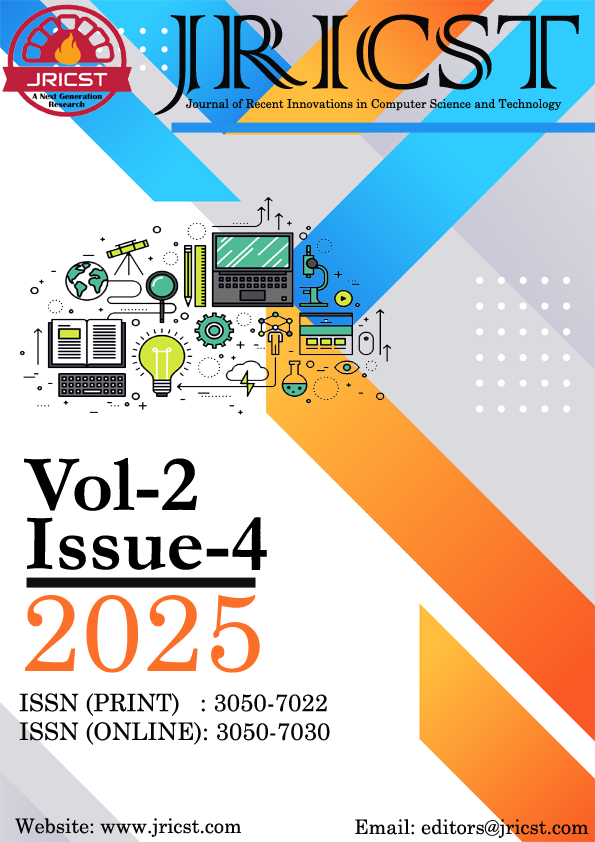Enhancing Organizational Performance and Strategic Forecasting Through Business Intelligence Technique
DOI:
https://doi.org/10.70454/JRICST.2025.20401Keywords:
Business Intelligence, Sales Forecasting, Data Visualization, Predictive Analytics, Organizational PerformanceAbstract
In this paper, show how BI applications can lead to sales forecasting and organizational performance improvements based on the case of a retail store. To detect patterns, performance issues and actionable results, a relatively simple business intelligence model based on descriptive, diagnostic and predictive analytics was applied. Although descriptive analytics revealed regional sales differences, diagnostic analytics found that too much discounting reduces profit. The comparison analysis confirmed that the proposals enable more profit, better discount management and improved performance in general when BI-based decision making is applied versus traditional methods. The present work evaluates five leading BI tools, namely Power BI, Tableau, Qlik Sense, Looker and SAP Business Objects based on their scalability, data integration and visualization features. In addition, future sales were predicted with the help of predictive models such as ARIMA, Prophet, etc., which contributed to inventory control and strategic alignment. The results highlight that BI solutions are core enablers of data-driven decision making, operational efficiency, and even continuous growth. With cloud and AI integration, BI provides real-time analytics to enable organizations stay competitive, agile, and responsive in today’s business landscape.
Downloads
References
[1] C. P. Gupta and V. V. R. Kumar, "Predictive Analytics: An AI Tool Enabling Organizations to Take Well-Informed Decisions," in Proc. 2024 Multimedia University Engineering Conference (MECON), Cyberjaya, Malaysia, 2024, pp. 1–5, doi: 10.1109/MECON62796.2024.10776357.
[2] A. Pradeep, "Enhancing Business Intelligence through Business Analytics and Data Mining Techniques using Python," in Proc. 2023 3rd Int. Conf. Intelligent Technologies (CONIT), Hubli, India, 2023, pp. 1–6, doi: 10.1109/CONIT59222.2023.10205708.
[3] M. Semwal, K. Akila, M. Manasa, P. S. Raj, Y. Motukuru and P. Karthik, "Machine Learning-Enabled Business Intelligence For Dynamic Pricing Strategies In E-Commerce," in Proc. 2024 2nd Int. Conf. Disruptive Technologies (ICDT), Greater Noida, India, 2024, pp. 116–120, doi: 10.1109/ICDT61202.2024.10489724.
[4] T. Maaitah, "The role of business intelligence tools in the decision making process and performance," J. Intell. Stud. Bus., vol. 13, no. 1, pp. 43–52, 2023.
[5] A. Gupta and P. Agarwal, "Enhancing Sales Forecasting Accuracy through Integrated Enterprise Resource Planning and Customer Relationship Management using Artificial Intelligence," in Proc. 2024 3rd Int. Conf. Artificial Intelligence for Internet of Things (AIIoT), Vellore, India, 2024, pp. 1–6, doi: 10.1109/AIIoT58432.2024.10574785.
[6] Z. Sun, L. Sun and K. Strang, "Big data analytics services for enhancing business intelligence," J. Comput. Inf. Syst., vol. 58, no. 2, pp. 162–169, 2018.
[7] Y. Niu, L. Ying, J. Yang, M. Bao and C. B. Sivaparthipan, "Organizational business intelligence and decision making using big data analytics," Inf. Process. Manag., vol. 58, no. 6, 2021, Art. no. 102725, doi: 10.1016/j.ipm.2021.102725.
[8] L. T. Becker and E. M. Gould, "Microsoft power BI: Extending Excel to manipulate, analyze, and visualize diverse data," Serials Rev., vol. 45, no. 3, pp. 184–188, 2019, doi: 10.1080/24751448.2018.1497381.
[9] S. Carlisle, "Software: Tableau and Microsoft Power BI," Technol. Archit. Des., vol. 2, no. 2, pp. 256–259, 2018.
[10] P. Labbe, C. Anjos, K. Solanki and J. DiMaso, Hands-On Business Intelligence with Qlik Sense: Implement Self-Service Data Analytics with Insights and Guidance from Qlik Sense Experts. Birmingham, UK: Packt Publ., 2019.
[11] "Evaluation of Top Cloud Service Providers’ BI Tools: A Comparison of Amazon Quicksight, Microsoft Power BI, and Google Looker," Int. J. Comput. Eng. Technol. (IJCET), vol. 15, no. 3, pp. 150–156, May–Jun. 2024, doi: 10.17605/OSF.IO/RKZG4.
[12] V. Singh, SAP Business Intelligence Quick Start Guide: Actionable Business Insights from the SAP BusinessObjects BI Platform. Birmingham, UK: Packt Publ., 2019.
[13] T. Boone, R. Ganeshan, A. Jain and N. R. Sanders, "Forecasting sales in the supply chain: Consumer analytics in the big data era," Int. J. Forecast., vol. 35, no. 1, pp. 170–180, 2019, doi: 10.1016/j.ijforecast.2018.09.003.
[14] C. M. Olszak, "Business intelligence systems for innovative development of organizations," Procedia Comput. Sci., vol. 207, pp. 1754–1762, 2022.
[15] E. Khanmohammadi, H. Safari, M. Zandieh, B. Malmir and E. B. Tirkolaee, "Development of Dynamic Balanced Scorecard Using Case-Based Reasoning Method and Adaptive Neuro-Fuzzy Inference System," in IEEE Transactions on Engineering Management, vol. 71, pp. 899-912, 2024, doi: 10.1109/TEM.2022.3140291.
[16] “Store Sales Forecasting Dataset,” Kaggle, Apr. 12, 2024. https://www.kaggle.com/datasets/tanayatipre/store-sales-forecasting-dataset?resource=download
Downloads
Published
Issue
Section
License
Copyright (c) 2025 Sonam Srivastava (Author)

This work is licensed under a Creative Commons Attribution 4.0 International License.
This is an Open Access article distributed under the term's of the Creative Common Attribution 4.0 International License permitting all use, distribution, and reproduction in any medium, provided the work is properly cited.






